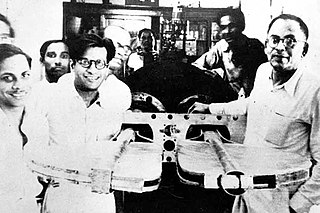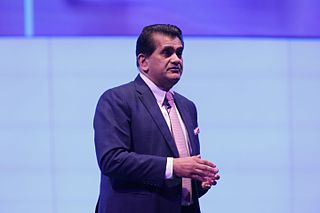
Jawaharlal Nehru was an Indian anti-colonial nationalist, statesman, secular humanist, social democrat, and author who was a central figure in India during the middle of the 20th century. Nehru was a principal leader of the Indian nationalist movement in the 1930s and 1940s. Upon India's independence in 1947, he served as the country's first prime minister for 16 years. Nehru promoted parliamentary democracy, secularism, and science and technology during the 1950s, powerfully influencing India's arc as a modern nation. In international affairs, he steered India clear of the two blocs of the Cold War. A well-regarded author, his books written in prison, such as Letters from a Father to His Daughter (1929), An Autobiography (1936) and The Discovery of India (1946), have been read around the world.

The Indian National Congress (INC), colloquially the Congress Party or simply the Congress, is a political party in India with deep roots in most regions of India. Founded on 28 December 1885, it was the first modern nationalist movement to emerge in the British Empire in Asia and Africa. From the late 19th century, and especially after 1920, under the leadership of Mahatma Gandhi, the Congress became the principal leader of the Indian independence movement. The Congress led India to independence from the United Kingdom, and significantly influenced other anti-colonial nationalist movements in the British Empire.

The Visvesvaraya Industrial and Technological Museum (VITM), Bangalore, India, a constituent unit of the National Council of Science Museums (NCSM), Ministry of Culture, Government of India, was established in memory of Sir M. Visvesvaraya. The 4,000 m2 (43,000 sq ft) building was constructed in Cubbon Park, and was inaugurated by the first Prime Minister of India, Pandit Jawaharlal Nehru, on July 14, 1962. The museum displays industrial products, scientific models and engines.
The Licence Raj or Permit Raj is a pejorative for the system of strict government control and regulation of the Indian economy that was in place from the 1950s to the early 1990s. Under this system, businesses in India were required to obtain licences from the government in order to operate, and these licences were often difficult to obtain.
From 1947 to 2017, the Indian economy was premised on the concept of planning. This was carried through the Five-Year Plans, developed, executed, and monitored by the Planning Commission (1951–2014) and the NITI Aayog (2015–2017). With the prime minister as the ex-officio chairman, the commission has a nominated deputy chairman, who holds the rank of a cabinet minister. Montek Singh Ahluwalia is the last deputy chairman of the commission. The Twelfth Plan completed its term in March 2017. Prior to the Fourth Plan, the allocation of state resources was based on schematic patterns rather than a transparent and objective mechanism, which led to the adoption for the Gadgil formula in 1969. Revised versions of the formula have been used since then to determine the allocation of central assistance for state plans. The new government led by Narendra Modi, elected in 2014, announced the dissolution of the Planning Commission, and its replacement by a think tank called the NITI Aayog.
The National Security Council (NSC) of India is an executive government agency tasked with advising the Prime Minister's Office on matters of national security and strategic interest. It was established by the former Prime Minister of India Atal Bihari Vajpayee on 19 November 1998, with Brajesh Mishra as the first National Security Advisor.

Sir Chintaman Dwarakanath DeshmukhICS was an Indian civil servant and the first Indian to be appointed the Governor of the Reserve Bank of India in 1943 by the British Raj authorities. He subsequently served as the Finance Minister in the Union Cabinet (1950–1956). It was during this time that he also became a founding member of the Governing Body of NCAER, the National Council of Applied Economic Research in New Delhi, India's first independent economic policy institute established in 1956 at the behest of Prime Minister Jawaharlal Nehru. After resignation from Union Cabinet he worked as Chairman of UGC (1956–1961). He served as Vice-Chancellor of University of Delhi (1962–67). He was also President of Indian Statistical Institute from 1945 to 1964, Honorary Chairman of National Book Trust (1957–60).
An ex officio member is a member of a body who is part of it by virtue of holding another office. The term ex officio is Latin, meaning literally 'from the office', and the sense intended is 'by right of office'; its use dates back to the Roman Republic.

Vijay Kumar Saraswat is an Indian scientist who formerly served as the Director General of the Defence Research and Development Organisation (DRDO) and the Chief Scientific Advisor to the Indian Minister of Defence. He retired as the Director General of the DRDO on 31 May 2003. Saraswat is presently a member of NITI Aayog, the Indian Government's apex public policy think tank and the President of Sree Chitra Tirunal Institute for Medical Sciences and Technology, Trivandrum. Saraswat is also a former Chancellor of Jawaharlal Nehru University.
Planning commissions are governmental bodies that make decisions about either Land-use planning or Economic planning, depending on the jurisdiction.

The National Development Council (NDC) or Rashtriya Vikas Parishad is the apex body for decision creating and deliberations on development matters in India, presided over by the Prime Minister. It was set up on 6 August 1952 to strengthen and mobilize the effort and resources of the nation in support of the Five Year Plans made by Planning Commission, to promote common economic policies in all vital spheres, and to ensure the balanced and rapid development of all parts of the country. The Council comprises the Prime Minister, the Union Cabinet Ministers, Chief Ministers of all States or their substitutes, representatives of the Union Territories and the members of the NITI Aayog.
Mahendra P. Lama is an Indian professor and a development economist who was the pro-vice chancellor of IGNOU and the founding vice chancellor of Sikkim University in India. At the age of 45, he became the youngest vice chancellor of a National Central University in India. He is presently a senior Professor in the School of International Studies, Jawaharlal Nehru University, New Delhi; Chief Economic Adviser in the Government of Sikkim and Member of the Eminent Persons Group on Nepal-India Relations appointed by the Prime Ministers of India and Nepal.

Basanti Dulal Nag Chaudhuri was an Indian physicist and academic, and a scientific advisor to the Government of India. He is known as one of the pioneers of nuclear physics in India. While serving as the Director General (1970-1974) to the Defence Research and Development Organisation (DRDO), he played influential role in Pokhran-I , India's first successful Nuclear bomb test on 18 May 1974. He also initiated the first feasibility studies on India's ballistic missile program.

The NITI Aayog serves as the apex public policy think tank of the Government of India, and the nodal agency tasked with catalyzing economic development, and fostering cooperative federalism and moving away from bargaining federalism through the involvement of State Governments of India in the economic policy-making process using a bottom-up approach. Its initiatives include "15-year road map", "7-year vision, strategy, and action plan", AMRUT, Digital India, Atal Innovation Mission, Medical Education Reform, agriculture reforms, Indices Measuring States’ Performance in Health, Education and Water Management, Sub-Group of Chief Ministers on Rationalization of Centrally Sponsored Schemes, Sub-Group of Chief Ministers on Swachh Bharat Abhiyan, Sub-Group of Chief Ministers on Skill Development, Task Forces on Agriculture and up of Poverty, and Transforming India Lecture Series.
Santosh Mehrotra is a development economist, whose research and writings have had most influence in the areas of labour, employment, skill development, on the relationship between human development and economic growth, child poverty, and the economics of education. He was an economic adviser in the United Nations system in New York City, Italy, and Thailand (1991–2006), and technocrat in the government of India (2006–2014), apart from making contributions to academic research since the mid-1980s. He has also in recent years established a reputation as an institution-builder in the field of research in India, despite facing difficult odds. He brings a combination of professional experience: with the Indian government as a policy maker and adviser, with international organisations as a technical expert, having lived on three continents and travelled to 63 countries providing technical advice to governments; and as an academic whose research work has been translated into French, Spanish, Portuguese, Italian and German.

Amitabh Kant is presently India's G20 Sherpa. He is an Indian bureaucrat and the former chief executive officer of NITI Aayog, a public policy think tank of the Government of India. He is a retired member of the Indian Administrative Service (IAS), the central civil service of the Government of India.
Pitambar Pant was an Indian independence activist, civil service officer and writer, best known for his contributions for the establishment of the Central Statistics Office and for changing Indian system of measurement to metric system. He served as the secretary to Jawaharlal Nehru, the then prime minister of India and headed the perspective planning division of the Planning Commission of India. He was also the author of a number of books on socialist economics. The Government of India awarded him the Padma Bhushan, the third highest civilian award, in 1973.
Ministry of Planning is a ministry in India. The minister responsible is the Hon'ble Prime Minister of India. The ministry's institutional capacity is exercised through the central agency: NITI Aayog.
Atmanirbhar Bharat, which translates to 'self-reliant India', is a phrase the Prime Minister of India Narendra Modi and his government used and popularised in relation to the country's economic development plans. The phrase is an umbrella concept for the Modi government's plans for India to play a larger role in the world economy, and for it to become more efficient, competitive and resilient.

Parameswaran Iyer is an Indian civil servant and the former CEO of NITI Aayog. He is currently serving as India's nominee as an Executive director in World Bank.









